Python programming | Fundamentals of Python programming
Download as pptx, pdf3 likes2,867 views
Basic Fundamentals of Python Programming. What is Python, History of python, Advantages, Disadvantages, feature of python, scope, and many more. Data Structure using Python, Object Oriented Programming using
1 of 12
Downloaded 63 times
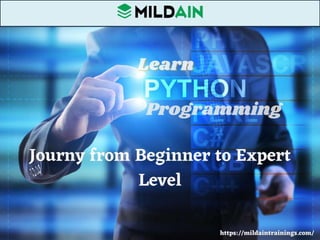
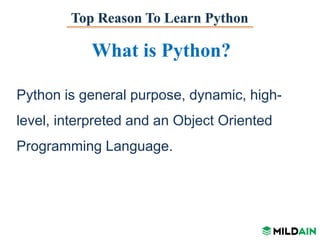
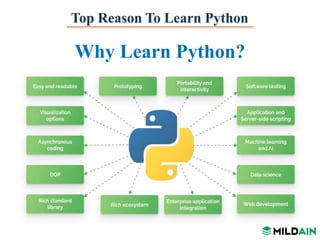

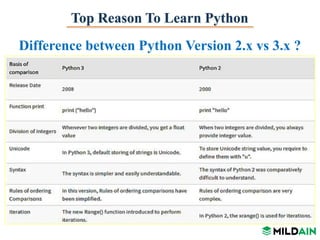
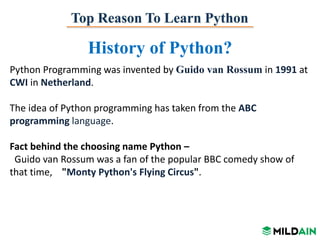
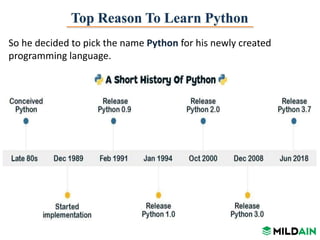

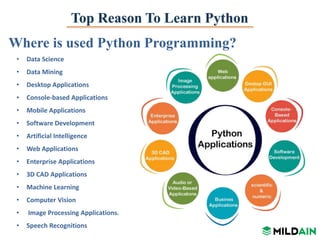


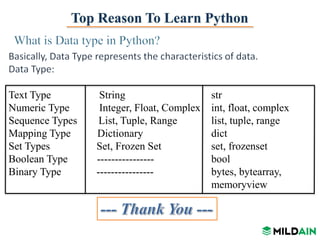
Ad
Recommended
Introduction to python



Introduction to pythonAyshwarya Baburam This document provides an overview of the Python programming language. It discusses what Python is, its key features, who uses it, common applications, and how to download and install Python. It then covers Python syntax concepts like identifiers, keywords, multiline statements, docstrings, indentation, comments, and string formatting. The document also introduces Python data types like numbers, strings, lists, tuples, dictionaries, sets and how to work with them. It describes how to convert between number types and access/update strings and lists. Finally, it discusses Python development environments like Anaconda and Spyder.
Python Programming



Python ProgrammingSaravanan T.M The document provides an introduction to Python programming. It discusses that Python is a high-level, interpreted, object-oriented, and general purpose programming language. It can be used for web development, scientific computing, desktop applications, and more. The document then covers Python basics like data types, variables, literals, operators, control flow statements, functions, modules and packages. It also discusses installing Python on Windows and writing the first Python program.
Python ppt



Python pptRohit Verma Python is a general purpose programming language created by Guido van Rossum in 1991. It is widely used by companies like Google, Facebook, and Dropbox for tasks like web development, data analysis, and machine learning. Python code is easy to read and write for beginners due to its simple syntax and readability. It supports features like object oriented programming, procedural programming, and functional programming.
Python Basics | Python Tutorial | Edureka



Python Basics | Python Tutorial | EdurekaEdureka! Youtube Link: https://youtu.be/woVJ4N5nl_s
** Python Certification Training: https://www.edureka.co/data-science-python-certification-course **
This Edureka PPT on 'Python Basics' will help you understand what exactly makes Python special and covers all the basics of Python programming along with examples.
Follow us to never miss an update in the future.
YouTube: https://www.youtube.com/user/edurekaIN
Instagram: https://www.instagram.com/edureka_learning/
Facebook: https://www.facebook.com/edurekaIN/
Twitter: https://twitter.com/edurekain
LinkedIn: https://www.linkedin.com/company/edureka
Castbox: https://castbox.fm/networks/505?country=in
Introduction to Python 



Introduction to Python amiable_indian The document provides an introduction to Python programming. It discusses installing and running Python, basic Python syntax like variables, data types, conditionals, and functions. It emphasizes that Python uses references rather than copying values, so assigning one variable to another causes both to refer to the same object.
Programming with Python



Programming with PythonRasan Samarasinghe Programming with Python - Delivered along with Certificate in C/C++ Programming - ESOFT Metro Campus
(Template - Virtusa Corporate)
Python - the basics



Python - the basicsUniversity of Technology The document provides an introduction to Python programming by discussing statements and syntax. It covers assignment statements, expression statements, print operations, conditional statements like if/else, and loop statements like while and for. It explains how Python programs are composed of modules containing statements with expressions. Truth tests for conditionals and built-in functions like range, zip that can be used in loops are also overviewed.
Python programming introduction



Python programming introductionSiddique Ibrahim This document provides an overview of basic Python programming concepts including programming languages, compilers, interpreters, linkers, loaders, Python syntax checking, Python virtual machine, commenting in Python, Python character sets, tokens, literals, variables, keywords, operators, delimiters, and the print function. It explains key elements like machine language uses 0s and 1s, high level languages are easier for humans, compilers translate to machine code while interpreters convert line by line, and linkers combine program modules into a single executable.
Variables & Data Types In Python | Edureka



Variables & Data Types In Python | EdurekaEdureka! YouTube Link: https://youtu.be/6yrsX752CWk
(** Python Certification Training: https://www.edureka.co/python **)
This Edureka PPT on 'Variables and Data Types in Python' will help you establish a foothold on Python by helping you learn basic concepts like variables and data types. Below are the topics covered in this PPT:
Introduction To Python
Applications Of Python
Variable Declaration
Variable Data Types
Type Conversion
Python Tutorial Playlist: https://goo.gl/WsBpKe
Blog Series: http://bit.ly/2sqmP4s
Follow us to never miss an update in the future.
YouTube: https://www.youtube.com/user/edurekaIN
Instagram: https://www.instagram.com/edureka_learning/
Facebook: https://www.facebook.com/edurekaIN/
Twitter: https://twitter.com/edurekain
LinkedIn: https://www.linkedin.com/company/edureka
Python Basics



Python Basicstusharpanda88 This document provides an introduction to the Python programming language. It covers Python's background, syntax, types, operators, control flow, functions, classes, tools, and IDEs. Key points include that Python is a multi-purpose, object-oriented language that is interpreted, strongly and dynamically typed. It focuses on readability and has a huge library of modules. Popular Python IDEs include Emacs, Vim, Komodo, PyCharm, and Eclipse.
Introduction to the basics of Python programming (part 1)



Introduction to the basics of Python programming (part 1)Pedro Rodrigues These are the slides of the first event of the meetup group Learn Python Den Haag. It covers some aspects of the basics of Python programming.
Python ppt



Python pptMohita Pandey Learn Python online and start coding on python,Get more detais of python and join free online python calsses on Almamapper.com.
Python - An Introduction



Python - An IntroductionSwarit Wadhe Python An Introduction, A presentation Developed by Swarit Wadhe. This Slide Will Give you basic information about python (Origin, Codes and difference from other languages).
I hope you'll find this helpfull and if you do please share it with your fellows.
Python Programming ppt



Python Programming pptismailmrribi This document provides an introduction to the Python programming language. It covers Python's history and features, including its syntax, types, operators, control flow, functions, classes, and tools. Python is a readable, dynamic language suitable for web development, GUIs, scripting, and more. It has a focus on readability and productivity. Major companies and organizations that use Python include Google, NASA, Dropbox, IBM, Instagram, and Mozilla.
Fundamentals of Python Programming



Fundamentals of Python ProgrammingKamal Acharya The document provides an introduction to Python programming including its features, uses, history, and installation process. Some key points covered include:
- Python is an interpreted, object-oriented programming language that is used for web development, scientific computing, and desktop applications.
- It was created by Guido van Rossum in 1991 and named after the Monty Python comedy group.
- To install Python on Windows, users download the latest version from python.org and run the installer, which also installs the IDLE development environment.
- The document then covers basic Python concepts like variables, data types, operators, and input/output functions.
Introduction to python



Introduction to pythonSyed Zaid Irshad This document provides an introduction to the Python programming language. It discusses why Python is used, what Python can be used for, its technical strengths, and its few downsides. It also provides instructions on installing Python and running a simple "Hello World" program. The key points are that Python is readable, maintainable, and has a small code size; it can be used for systems programming, GUIs, scripting, databases, and more; and its main downside is potential slower execution speed compared to compiled languages like C and C++.
Python: Modules and Packages



Python: Modules and PackagesDamian T. Gordon Modules in Python allow organizing classes into files to make them available and easy to find. Modules are simply Python files that can import classes from other modules in the same folder. Packages allow further organizing modules into subfolders, with an __init__.py file making each subfolder a package. Modules can import classes from other modules or packages using either absolute or relative imports, and the __init__.py can simplify imports from its package. Modules can also contain global variables and classes to share resources across a program.
Presentation on python



Presentation on pythonwilliam john The document discusses Bram Cohen's view that Python is a good language for maintainability as it has clean syntax, object encapsulation, good library support, and optional parameters, and then provides details about the history and features of the Python programming language such as being dynamically typed, having a large standard library, and being cross-platform.
Python basic



Python basicSaifuddin Kaijar Python is a versatile, object-oriented programming language that can be used for web development, data analysis, and more. It has a simple syntax and is easy to read and learn. Key features include being interpreted, dynamically typed, supporting functional and object-oriented programming. Common data types include numbers, strings, lists, dictionaries, tuples, and files. Functions and classes can be defined to organize and reuse code. Regular expressions provide powerful string manipulation. Python has a large standard library and is used widely in areas like GUIs, web scripting, AI, and scientific computing.
Python libraries



Python librariesProf. Dr. K. Adisesha This document discusses Python libraries and modules. It defines a library as a collection of modules that provide specific functionality. The standard library contains commonly used modules like math and random. Other important libraries mentioned are NumPy, SciPy, and tkinter. A module is a .py file that contains related variables, classes, functions etc. Modules can be imported using import, from, or from * statements. Namespaces and module aliasing are also covered. The document concludes by explaining how to create Python packages and the role of the __init__.py file in making a directory a package.
Introduction to Python



Introduction to PythonNowell Strite This document provides an introduction and overview of the Python programming language. It covers Python's history and key features such as being object-oriented, dynamically typed, batteries included, and focusing on readability. It also discusses Python's syntax, types, operators, control flow, functions, classes, imports, error handling, documentation tools, and popular frameworks/IDEs. The document is intended to give readers a high-level understanding of Python.
Python programming : Files



Python programming : FilesEmertxe Information Technologies Pvt Ltd The document discusses files in Python. It defines a file as an object that stores data, information, settings or commands used with a computer program. There are two main types of files - text files which store data as strings, and binary files which store data as bytes. The document outlines how to open, read, write, append, close and manipulate files in Python using functions like open(), read(), write(), close() etc. It also discusses pickling and unpickling objects to binary files for serialization. Finally, it covers working with directories and running other programs from Python.
Introduction to python programming



Introduction to python programmingSrinivas Narasegouda If you want to learn the basics of Python programming language here it is in the simplest way. Enjoy learning.
Python Tutorial | Python Tutorial for Beginners | Python Training | Edureka



Python Tutorial | Python Tutorial for Beginners | Python Training | EdurekaEdureka! This Edureka Python tutorial will help you in understanding the various fundamentals of Python programming with examples in detail. This Python tutorial helps you to learn following topics:
1. Introduction to Python
2. Who uses Python
3. Features of Python
4. Operators in Python
5. Datatypes in Python
6. Flow Control
7. Functions in Python
8. File Handling in Python
Python Functions



Python FunctionsMohammed Sikander Python functions allow for reusable code through defining functions, passing arguments, returning values, and setting scopes. Functions can take positional or keyword arguments, as well as variable length arguments. Default arguments allow functions to specify default values for optional parameters. Functions are objects that can be assigned to variables and referenced later.
Programming Fundamentals



Programming FundamentalsTrivuz ত্রিভুজ For most programming/scripting languages the concepts are all the same. The only thing that changes is the syntax in which it is written. Some languages may be easier to remember than others, but if you follow the basic guide line, it will make learning any programming language easier. This is in no way supposed to teach you everything about programming, just a general knowledge so when you do program you will understand what you are doing a little bit better.
Python



PythonShivam Gupta This document provides an overview of the Python programming language. It begins by explaining what Python is - a general purpose, interpreted programming language that can be used as both a programming and scripting language. It then discusses the differences between programs and scripting languages. The history and creator of Python, Guido van Rossum, are outlined. The document explores the scope of Python and what tasks it can be used for. Popular companies and industries that use Python today are listed. Reasons why people use Python, such as it being free, powerful, and portable, are provided. Instructions for installing Python and running Python code are included. The document covers Python code execution and introduces basic Python concepts like variables, strings, data types, lists
Data types in python



Data types in pythonRaginiJain21 The document discusses Python data types. It describes the numeric data types integer, float, and complex which are used to represent numbers. Integer is a whole number without decimals, float has decimals, and complex numbers have real and imaginary parts. None is described as a null value. Strings are arrays of characters and can be indexed. Tuples and lists are ordered collections that can hold heterogeneous data types. Sets are unordered collections of unique items. Dictionaries are unordered collections of key-value pairs that allow accessing values via keys.
Introduction to Python – Learn Python Programming.pptx



Introduction to Python – Learn Python Programming.pptxHassanShah396906 This document provides an introduction to the Python programming language. It discusses what Python is, why it is called Python, its history, why one should learn Python, its applications, architecture and working, and key constructs like functions, classes, modules, and packages. Python is an interpreted, object-oriented programming language that is easy to read and can be used for a wide range of tasks from building websites to data analysis to artificial intelligence.
More Related Content
What's hot (20)
Variables & Data Types In Python | Edureka



Variables & Data Types In Python | EdurekaEdureka! YouTube Link: https://youtu.be/6yrsX752CWk
(** Python Certification Training: https://www.edureka.co/python **)
This Edureka PPT on 'Variables and Data Types in Python' will help you establish a foothold on Python by helping you learn basic concepts like variables and data types. Below are the topics covered in this PPT:
Introduction To Python
Applications Of Python
Variable Declaration
Variable Data Types
Type Conversion
Python Tutorial Playlist: https://goo.gl/WsBpKe
Blog Series: http://bit.ly/2sqmP4s
Follow us to never miss an update in the future.
YouTube: https://www.youtube.com/user/edurekaIN
Instagram: https://www.instagram.com/edureka_learning/
Facebook: https://www.facebook.com/edurekaIN/
Twitter: https://twitter.com/edurekain
LinkedIn: https://www.linkedin.com/company/edureka
Python Basics



Python Basicstusharpanda88 This document provides an introduction to the Python programming language. It covers Python's background, syntax, types, operators, control flow, functions, classes, tools, and IDEs. Key points include that Python is a multi-purpose, object-oriented language that is interpreted, strongly and dynamically typed. It focuses on readability and has a huge library of modules. Popular Python IDEs include Emacs, Vim, Komodo, PyCharm, and Eclipse.
Introduction to the basics of Python programming (part 1)



Introduction to the basics of Python programming (part 1)Pedro Rodrigues These are the slides of the first event of the meetup group Learn Python Den Haag. It covers some aspects of the basics of Python programming.
Python ppt



Python pptMohita Pandey Learn Python online and start coding on python,Get more detais of python and join free online python calsses on Almamapper.com.
Python - An Introduction



Python - An IntroductionSwarit Wadhe Python An Introduction, A presentation Developed by Swarit Wadhe. This Slide Will Give you basic information about python (Origin, Codes and difference from other languages).
I hope you'll find this helpfull and if you do please share it with your fellows.
Python Programming ppt



Python Programming pptismailmrribi This document provides an introduction to the Python programming language. It covers Python's history and features, including its syntax, types, operators, control flow, functions, classes, and tools. Python is a readable, dynamic language suitable for web development, GUIs, scripting, and more. It has a focus on readability and productivity. Major companies and organizations that use Python include Google, NASA, Dropbox, IBM, Instagram, and Mozilla.
Fundamentals of Python Programming



Fundamentals of Python ProgrammingKamal Acharya The document provides an introduction to Python programming including its features, uses, history, and installation process. Some key points covered include:
- Python is an interpreted, object-oriented programming language that is used for web development, scientific computing, and desktop applications.
- It was created by Guido van Rossum in 1991 and named after the Monty Python comedy group.
- To install Python on Windows, users download the latest version from python.org and run the installer, which also installs the IDLE development environment.
- The document then covers basic Python concepts like variables, data types, operators, and input/output functions.
Introduction to python



Introduction to pythonSyed Zaid Irshad This document provides an introduction to the Python programming language. It discusses why Python is used, what Python can be used for, its technical strengths, and its few downsides. It also provides instructions on installing Python and running a simple "Hello World" program. The key points are that Python is readable, maintainable, and has a small code size; it can be used for systems programming, GUIs, scripting, databases, and more; and its main downside is potential slower execution speed compared to compiled languages like C and C++.
Python: Modules and Packages



Python: Modules and PackagesDamian T. Gordon Modules in Python allow organizing classes into files to make them available and easy to find. Modules are simply Python files that can import classes from other modules in the same folder. Packages allow further organizing modules into subfolders, with an __init__.py file making each subfolder a package. Modules can import classes from other modules or packages using either absolute or relative imports, and the __init__.py can simplify imports from its package. Modules can also contain global variables and classes to share resources across a program.
Presentation on python



Presentation on pythonwilliam john The document discusses Bram Cohen's view that Python is a good language for maintainability as it has clean syntax, object encapsulation, good library support, and optional parameters, and then provides details about the history and features of the Python programming language such as being dynamically typed, having a large standard library, and being cross-platform.
Python basic



Python basicSaifuddin Kaijar Python is a versatile, object-oriented programming language that can be used for web development, data analysis, and more. It has a simple syntax and is easy to read and learn. Key features include being interpreted, dynamically typed, supporting functional and object-oriented programming. Common data types include numbers, strings, lists, dictionaries, tuples, and files. Functions and classes can be defined to organize and reuse code. Regular expressions provide powerful string manipulation. Python has a large standard library and is used widely in areas like GUIs, web scripting, AI, and scientific computing.
Python libraries



Python librariesProf. Dr. K. Adisesha This document discusses Python libraries and modules. It defines a library as a collection of modules that provide specific functionality. The standard library contains commonly used modules like math and random. Other important libraries mentioned are NumPy, SciPy, and tkinter. A module is a .py file that contains related variables, classes, functions etc. Modules can be imported using import, from, or from * statements. Namespaces and module aliasing are also covered. The document concludes by explaining how to create Python packages and the role of the __init__.py file in making a directory a package.
Introduction to Python



Introduction to PythonNowell Strite This document provides an introduction and overview of the Python programming language. It covers Python's history and key features such as being object-oriented, dynamically typed, batteries included, and focusing on readability. It also discusses Python's syntax, types, operators, control flow, functions, classes, imports, error handling, documentation tools, and popular frameworks/IDEs. The document is intended to give readers a high-level understanding of Python.
Python programming : Files



Python programming : FilesEmertxe Information Technologies Pvt Ltd The document discusses files in Python. It defines a file as an object that stores data, information, settings or commands used with a computer program. There are two main types of files - text files which store data as strings, and binary files which store data as bytes. The document outlines how to open, read, write, append, close and manipulate files in Python using functions like open(), read(), write(), close() etc. It also discusses pickling and unpickling objects to binary files for serialization. Finally, it covers working with directories and running other programs from Python.
Introduction to python programming



Introduction to python programmingSrinivas Narasegouda If you want to learn the basics of Python programming language here it is in the simplest way. Enjoy learning.
Python Tutorial | Python Tutorial for Beginners | Python Training | Edureka



Python Tutorial | Python Tutorial for Beginners | Python Training | EdurekaEdureka! This Edureka Python tutorial will help you in understanding the various fundamentals of Python programming with examples in detail. This Python tutorial helps you to learn following topics:
1. Introduction to Python
2. Who uses Python
3. Features of Python
4. Operators in Python
5. Datatypes in Python
6. Flow Control
7. Functions in Python
8. File Handling in Python
Python Functions



Python FunctionsMohammed Sikander Python functions allow for reusable code through defining functions, passing arguments, returning values, and setting scopes. Functions can take positional or keyword arguments, as well as variable length arguments. Default arguments allow functions to specify default values for optional parameters. Functions are objects that can be assigned to variables and referenced later.
Programming Fundamentals



Programming FundamentalsTrivuz ত্রিভুজ For most programming/scripting languages the concepts are all the same. The only thing that changes is the syntax in which it is written. Some languages may be easier to remember than others, but if you follow the basic guide line, it will make learning any programming language easier. This is in no way supposed to teach you everything about programming, just a general knowledge so when you do program you will understand what you are doing a little bit better.
Python



PythonShivam Gupta This document provides an overview of the Python programming language. It begins by explaining what Python is - a general purpose, interpreted programming language that can be used as both a programming and scripting language. It then discusses the differences between programs and scripting languages. The history and creator of Python, Guido van Rossum, are outlined. The document explores the scope of Python and what tasks it can be used for. Popular companies and industries that use Python today are listed. Reasons why people use Python, such as it being free, powerful, and portable, are provided. Instructions for installing Python and running Python code are included. The document covers Python code execution and introduces basic Python concepts like variables, strings, data types, lists
Data types in python



Data types in pythonRaginiJain21 The document discusses Python data types. It describes the numeric data types integer, float, and complex which are used to represent numbers. Integer is a whole number without decimals, float has decimals, and complex numbers have real and imaginary parts. None is described as a null value. Strings are arrays of characters and can be indexed. Tuples and lists are ordered collections that can hold heterogeneous data types. Sets are unordered collections of unique items. Dictionaries are unordered collections of key-value pairs that allow accessing values via keys.
Similar to Python programming | Fundamentals of Python programming (20)
Introduction to Python – Learn Python Programming.pptx



Introduction to Python – Learn Python Programming.pptxHassanShah396906 This document provides an introduction to the Python programming language. It discusses what Python is, why it is called Python, its history, why one should learn Python, its applications, architecture and working, and key constructs like functions, classes, modules, and packages. Python is an interpreted, object-oriented programming language that is easy to read and can be used for a wide range of tasks from building websites to data analysis to artificial intelligence.
introduction to Python (for beginners)



introduction to Python (for beginners)guobichrng Python supports multiple programming paradigms, including object-oriented, imperative and functional programming or procedural styles. It features a dynamic type system and automatic memory management and has a large and comprehensive standard library.
A slightly modified version of original "An introduction to Python
for absolute beginners" slides. For credits please check the second page. I used this presentation for my school's internal Python course. thank you forviewing
Core Python.doc



Core Python.docJyoti shukla Python is a general purpose, high-level programming language created by Guido van Rossum in 1991. It is an interpreted language with object-oriented, imperative, and functional programming styles. Some key features of Python include being easy to read and learn, having a large standard library, being cross-platform, and supporting multiple programming paradigms. Common uses of Python include web development, data analysis, and artificial intelligence/machine learning applications.
Introduction to python



Introduction to pythonNikhil Kapoor This document provides an introduction to the Python programming language. It discusses that Python was created by Guido Van Rossum in 1989. It is an interpreted, interactive, object-oriented language with simple syntax making it ideal for beginners. The document outlines Python's history, features, supported platforms, comparisons to other languages, popular uses and applications.
Python Class 1



Python Class 1arijit banerjee Python is an interpreted, object-oriented, high-level programming language that emphasizes code readability. It has a large standard library, dynamic typing, and is available for free on all major platforms. Python supports multiple programming paradigms including procedural, object-oriented, and functional programming. It is commonly used for web development, scripting, and rapid application development due to its simple syntax and readability.
summer t.pdf



summer t.pdfRITVIKKAPOOR10 Python has two main programming modes - interactive and script. The interactive mode allows executing commands directly in the interpreter while the script mode involves writing code in a .py file and running it. This report details a summer training program on Python programming conducted by Rupal Gandhi. It provides an introduction to Python including its history and advantages. It also covers various Python concepts like variables, data types, operators, strings, lists, tuples, dictionaries, functions and file operations with examples.
Introduction to Python Programming Basics



Introduction to Python Programming BasicsDhana malar Python is a popular high-level programming language that can be used for a wide range of applications from simple scripts to complex machine learning programs. It has a simple syntax, extensive standard library, and support for code reuse through modules and packages. Some key strengths of Python include its huge collection of standard libraries for tasks like machine learning, web development, scientific computing, and more. It is also an interpreted language, making it easy to learn and use for both simple and complex programming tasks.
A Brief Introduction to Python - English



A Brief Introduction to Python - EnglishDevashish Negi This is a slide for Basic Introduction to Python
Python basics



Python basicsssuser4e32df Python is a general-purpose, high-level programming language that is widely used for web and application development, data science, and machine learning. It was created by Guido van Rossum in 1991 and takes inspiration from languages like C, Java, Lisp, and Modula-3. Python code is human-readable and has an easy to learn syntax that uses indentation rather than brackets to indicate blocks of code. It supports multiple programming paradigms including object-oriented, imperative, and functional programming.
Python PPT.pptx



Python PPT.pptxJosephMuez2 This document provides an overview of Python and introduces some of its key concepts. It discusses Python's origins in the late 1980s and its increasing popularity today. The document outlines Python's main features like being easy to use, interpreted, high-level, dynamically typed, extensible, and having many available libraries. It also lists some common uses of Python like for web applications, data analytics, AI/ML, business, and more. Finally, the document introduces lessons on installing Python/PyCharm, understanding data types, working with numbers and strings, and using tuples and lists.
Presentation.pptx



Presentation.pptxAyushmanTiwari11 This document is a report on Python for a class. It includes sections on the history of Python, why it is a good choice for learning programming, its core characteristics like being interpreted and object-oriented, common data structures like lists and dictionaries, the NumPy package for scientific computing, and a conclusion about the benefits of using Python as a teaching language.
Presentation.pptx



Presentation.pptxAyushmanTiwari11 This document is a report on Python for a class. It includes sections on the history of Python, why it is a good choice for learning programming, its core characteristics like being interpreted and object-oriented, common data structures like lists and dictionaries, the NumPy package for scientific computing, and a conclusion about the benefits of using Python as a teaching language.
Python programming



Python programmingGanesh Bhosale Python is an interpreted, object-oriented, high-level programming language with dynamic semantics. It was created by Guido van Rossum in 1991 and named after the BBC show Monty Python's Flying Circus. Python is used for web development, data analysis, scientific computing, and more. It has a simple syntax and is highly readable. Key features of Python include object orientation, dynamic typing, automatic memory management, and a large standard library. Common uses of Python include data science, web development, education, systems administration, and more. Major companies that use Python include Google, Facebook, NASA, and Netflix.
Python Introduction its a oop language and easy to use



Python Introduction its a oop language and easy to useSrajanCollege1 This document provides an introduction to Python and data visualization using Python. It discusses that Python is a high-level, interpreted, interactive and object-oriented scripting language used for software, website and app development. It then covers why Python is easy to learn and maintain, and has a broad standard library. The document lists different Python versions and popular Python IDEs. It also introduces basic Python programs, data types, operators, functions, conditional statements, loops, lists, tuples, dictionaries, and concludes with examples of data visualization using Matplotlib and collecting historical stock data for visualization.
Python Basics for python understanding.pptx



Python Basics for python understanding.pptxShubhamNain11 This presentation is used to start python program as a starter This presentation is used to start python program as a starter This presentation is used to start python program as a starter This presentation is used to start python program as a starter This presentation is used to start python program as a starter This presentation is used to start python program as a starter This presentation is used to start python program as a starter This presentation is used to start python program as a starter This presentation is used to start python program as a starter This presentation is used to start python program as a starter This presentation is used to start python program as a starter This presentation is used to start python program as a starter This presentation is used to start python program as a starter This presentation is used to start python program as a starter This presentation is used to start python program as a starter This presentation is used to start python program as a starter This presentation is used to start python program as a starter This presentation is used to start python program as a starter This presentation is used to start python program as a starter This presentation is used to start python program as a starter This presentation is used to start python program as a starter This presentation is used to start python program as a starter This presentation is used to start python program as a starter This presentation is used to start python program as a starter This presentation is used to start python program as a starter This presentation is used to start python program as a starter This presentation is used to start python program as a starter This presentation is used to start python program as a starter This presentation is used to start python program as a starter This presentation is used to start python program as a starter This presentation is used to start python program as a starter This presentation is used to start python program as a starter This presentation is used to start python program as a starter This presentation is used to start python program as a starter This presentation is used to start python program as a starter This presentation is used to start python program as a starter This presentation is used to start python program as a starter This presentation is used to start python program as a starter This presentation is used to start python program as a starter This presentation is used to start python program as a starter This presentation is used to start python program as a starter This presentation is used to start python program as a starter This presentation is used to start python program as a starter This presentation is used to start python program as a starter This presentation is used to start python program as a starter This presentation is used to start python program as a starter This presentation is used to start python program as a starter This presentation is used to start pyth
Python Tutorial .pdf



Python Tutorial .pdfSudhanshiBakre1 This document provides an overview of the Python programming language. It discusses the history of Python, noting that it was created in 1989 by Guido van Rossum as a hobby project. Python is now one of the most widely used languages, particularly in areas like data science, machine learning, and web development. The document also outlines why Python is a useful language to learn, noting opportunities in data science, its ease of use, and job stability. Finally, it briefly discusses how Python files are run and interpreted.
Ad
Recently uploaded (20)
june 10 2025 ppt for madden on art science is over.pptx



june 10 2025 ppt for madden on art science is over.pptxroger malina art science is over -talk by roger malina for jack madden group
Adam Grant: Transforming Work Culture Through Organizational Psychology



Adam Grant: Transforming Work Culture Through Organizational PsychologyPrachi Shah This presentation explores the groundbreaking work of Adam Grant, renowned organizational psychologist and bestselling author. It highlights his key theories on giving, motivation, leadership, and workplace dynamics that have revolutionized how organizations think about productivity, collaboration, and employee well-being. Ideal for students, HR professionals, and leadership enthusiasts, this deck includes insights from his major works like Give and Take, Originals, and Think Again, along with interactive elements for enhanced engagement.
TV Shows and web-series quiz | QUIZ CLUB OF PSGCAS | 13TH MARCH 2025



TV Shows and web-series quiz | QUIZ CLUB OF PSGCAS | 13TH MARCH 2025Quiz Club of PSG College of Arts & Science HOW YOU DOIN'?
Cool, cool, cool...
Because that's what she said after THE QUIZ CLUB OF PSGCAS' TV SHOW quiz.
Grab your popcorn and be seated.
QM: THARUN S A
BCom Accounting and Finance (2023-26)
THE QUIZ CLUB OF PSGCAS.
Black and White Illustrative Group Project Presentation.pdf (1).pdf



Black and White Illustrative Group Project Presentation.pdf (1).pdfAnnasofiaUrsini mmmmmmmmmmmmmmmmmmmmmmmmmmmmmmmmmm
Hemiptera & Neuroptera: Insect Diversity.pptx



Hemiptera & Neuroptera: Insect Diversity.pptxArshad Shaikh *Order Hemiptera:*
Hemiptera, commonly known as true bugs, is a large and diverse order of insects that includes cicadas, aphids, leafhoppers, and shield bugs. Characterized by their piercing-sucking mouthparts, Hemiptera feed on plant sap, other insects, or small animals. Many species are significant pests, while others are beneficial predators.
*Order Neuroptera:*
Neuroptera, also known as net-winged insects, is an order of insects that includes lacewings, antlions, and owlflies. Characterized by their delicate, net-like wing venation and large, often prominent eyes, Neuroptera are predators that feed on other insects, playing an important role in biological control. Many species have aquatic larvae, adding to their ecological diversity.
Optimization technique in pharmaceutical product development.pptx



Optimization technique in pharmaceutical product development.pptxUrmiPrajapati3 Optimization techniques in pharmaceutical product development
Parenting Teens: Supporting Trust, resilience and independence



Parenting Teens: Supporting Trust, resilience and independencePooky Knightsmith For more information about my speaking and training work, visit: https://www.pookyknightsmith.com/speaking/
SESSION OVERVIEW:
Parenting Teens: Supporting Trust, Resilience & Independence
The teenage years bring new challenges—for teens and for you. In this practical session, we’ll explore how to support your teen through emotional ups and downs, growing independence, and the pressures of school and social life.
You’ll gain insights into the teenage brain and why boundary-pushing is part of healthy development, along with tools to keep communication open, build trust, and support emotional resilience. Expect honest ideas, relatable examples, and space to connect with other parents.
By the end of this session, you will:
• Understand how teenage brain development affects behaviour and emotions
• Learn ways to keep communication open and supportive
• Explore tools to help your teen manage stress and bounce back from setbacks
• Reflect on how to encourage independence while staying connected
• Discover simple strategies to support emotional wellbeing
• Share experiences and ideas with other parents
How to Manage Upselling of Subscriptions in Odoo 18



How to Manage Upselling of Subscriptions in Odoo 18Celine George Subscriptions in Odoo 18 are designed to auto-renew indefinitely, ensuring continuous service for customers. However, businesses often need flexibility to adjust pricing or quantities based on evolving customer needs.
EUPHORIA GENERAL QUIZ FINALS | QUIZ CLUB OF PSGCAS | 21 MARCH 2025



EUPHORIA GENERAL QUIZ FINALS | QUIZ CLUB OF PSGCAS | 21 MARCH 2025Quiz Club of PSG College of Arts & Science RE-LIVE THE EUPHORIA!!!!
The Quiz club of PSGCAS brings to you a fun-filled breezy general quiz set from numismatics to sports to pop culture.
Re-live the Euphoria!!!
QM: Eiraiezhil R K,
BA Economics (2022-25),
The Quiz club of PSGCAS
How to Create an Event in Odoo 18 - Odoo 18 Slides



How to Create an Event in Odoo 18 - Odoo 18 SlidesCeline George Creating an event in Odoo 18 is a straightforward process that allows you to manage various aspects of your event efficiently.
Odoo 18 Events Module is a powerful tool for organizing and managing events of all sizes, from conferences and workshops to webinars and meetups.
How to Manage & Create a New Department in Odoo 18 Employee



How to Manage & Create a New Department in Odoo 18 EmployeeCeline George In Odoo 18's Employee module, organizing your workforce into departments enhances management and reporting efficiency. Departments are a crucial organizational unit within the Employee module.
Pests of Rice: Damage, Identification, Life history, and Management.pptx



Pests of Rice: Damage, Identification, Life history, and Management.pptxArshad Shaikh Rice pests can significantly impact crop yield and quality. Major pests include the brown plant hopper (Nilaparvata lugens), which transmits viruses like rice ragged stunt and grassy stunt; the yellow stem borer (Scirpophaga incertulas), whose larvae bore into stems causing deadhearts and whiteheads; and leaf folders (Cnaphalocrocis medinalis), which feed on leaves reducing photosynthetic area. Other pests include rice weevils (Sitophilus oryzae) and gall midges (Orseolia oryzae). Effective management strategies are crucial to minimize losses.
Module 4 Presentation - Enhancing Competencies and Engagement Strategies in Y...



Module 4 Presentation - Enhancing Competencies and Engagement Strategies in Y...GeorgeDiamandis11 Enhancing Competencies and Engagement Strategies in Youth Work
How to Create Quotation Templates Sequence in Odoo 18 Sales



How to Create Quotation Templates Sequence in Odoo 18 SalesCeline George In this slide, we’ll discuss on how to create quotation templates sequence in Odoo 18 Sales. Odoo 18 Sales offers a variety of quotation templates that can be used to create different types of sales documents.
BUSINESS QUIZ PRELIMS | QUIZ CLUB OF PSGCAS | 9 SEPTEMBER 2024



BUSINESS QUIZ PRELIMS | QUIZ CLUB OF PSGCAS | 9 SEPTEMBER 2024Quiz Club of PSG College of Arts & Science THE QUIZ CLUB OF PSGCAS BRINGS T0 YOU A FUN-FILLED, SEAT EDGE BUSINESS QUIZ
DIVE INTO THE PRELIMS OF BIZCOM 2024
QM: GOWTHAM S
BCom (2022-25)
THE QUIZ CLUB OF PSGCAS
TV Shows and web-series quiz | QUIZ CLUB OF PSGCAS | 13TH MARCH 2025



TV Shows and web-series quiz | QUIZ CLUB OF PSGCAS | 13TH MARCH 2025Quiz Club of PSG College of Arts & Science
EUPHORIA GENERAL QUIZ FINALS | QUIZ CLUB OF PSGCAS | 21 MARCH 2025



EUPHORIA GENERAL QUIZ FINALS | QUIZ CLUB OF PSGCAS | 21 MARCH 2025Quiz Club of PSG College of Arts & Science
BUSINESS QUIZ PRELIMS | QUIZ CLUB OF PSGCAS | 9 SEPTEMBER 2024



BUSINESS QUIZ PRELIMS | QUIZ CLUB OF PSGCAS | 9 SEPTEMBER 2024Quiz Club of PSG College of Arts & Science
Ad
Python programming | Fundamentals of Python programming
- 2. Top Reason To Learn Python What is Python? Python is general purpose, dynamic, high- level, interpreted and an Object Oriented Programming Language.
- 3. Top Reason To Learn Python Why Learn Python?
- 4. Top Reason To Learn Python Advantages vs Disadvantages?
- 5. Top Reason To Learn Python Difference between Python Version 2.x vs 3.x ?
- 6. Top Reason To Learn Python History of Python? Python Programming was invented by Guido van Rossum in 1991 at CWI in Netherland. The idea of Python programming has taken from the ABC programming language. Fact behind the choosing name Python – Guido van Rossum was a fan of the popular BBC comedy show of that time, "Monty Python's Flying Circus".
- 7. Top Reason To Learn Python So he decided to pick the name Python for his newly created programming language.
- 8. Top Reason To Learn Python Features of Python Programming?
- 9. Top Reason To Learn Python Where is used Python Programming? • Data Science • Data Mining • Desktop Applications • Console-based Applications • Mobile Applications • Software Development • Artificial Intelligence • Web Applications • Enterprise Applications • 3D CAD Applications • Machine Learning • Computer Vision • Image Processing Applications. • Speech Recognitions
- 10. Top Reason To Learn Python Python Popular Frameworks and Libraries Web development (Server-side) - Django, Flask, Pyramid, CherryPy GUIs based applications - Tk, PyGTK, PyQt, PyJs, etc. Machine Learning - TensorFlow, PyTorch Scikit-learn, Matplotlib, Scipy, etc. Mathematics - Numpy, Pandas, etc.
- 11. Top Reason To Learn Python Taking Input to the User input() function, which is used to take input from the user. print() function, which is used to display the output on screen. For Example: ------------------------------------------------------------------------------ X = input(“Input function takes the value as a string”) print(X) ------------------------------------------------------------------------------ Output: Input function takes the value as a string
- 12. Top Reason To Learn Python Text Type String str Numeric Type Integer, Float, Complex int, float, complex Sequence Types List, Tuple, Range list, tuple, range Mapping Type Dictionary dict Set Types Set, Frozen Set set, frozenset Boolean Type ---------------- bool Binary Type ---------------- bytes, bytearray, memoryview








